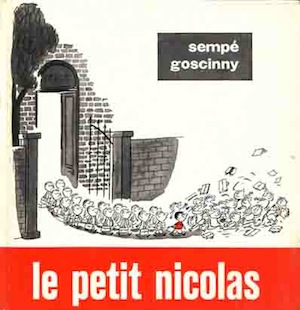Le Petit Nicolas facts for kids
Le Petit Nicolas (which means Little Nicholas) is a super popular series of French books for kids. It was created by René Goscinny and illustrated by Jean-Jacques Sempé. The very first book came out on March 30, 1959. These books show a fun, dream-like version of what childhood was like in France during the 1950s.
Contents
What is Le Petit Nicolas About?
The idea for Le Petit Nicolas actually started as a comic strip. This comic strip appeared in a magazine called Le Moustique from 1956 to 1958. Sempé drew the pictures, and Goscinny wrote the stories.
The books are special because they are told by Nicolas himself. This makes the stories feel very personal and funny. Nicolas tells his adventures using simple language, like a kid would. He often uses long sentences and words you might hear in a schoolyard. A lot of the humor comes from Nicolas not quite understanding what the grown-ups are doing.
At the same time, the books also gently make fun of adults. Nicolas's simple way of seeing the world shows how grown-ups can sometimes be a bit silly. This fresh way of telling stories, focusing on a child's view, made Le Petit Nicolas a very important book in children's literature.
Meet the Characters
Here are some of the main characters from the French books. Their names in the English translation by Anthea Bell are in square brackets:
- Nicolas [Nicholas]: He is the main character! Nicolas is kind and cares a lot about friendship. He loves his parents and believes in fairness. He isn't the best at math and is the smallest kid in his class.
- Clotaire [Matthew]: He is always at the bottom of the class.
- Alceste [Alex]: Nicolas's best friend. He is a bit chubby and loves to eat all the time.
- Eudes [Eddie]: He is very strong. He likes to playfully punch his friends on the nose.
- Geoffroy [Geoffrey]: His dad is super rich. He buys Geoffroy anything he wants!
- Agnan [Cuthbert]: He is the smartest in the class and the teacher's favorite. Because of this, no one really likes him. You can't hit him even if you want to, because he wears glasses.
- Joachim [Jeremy]: He has a little brother at home.
- Maixent [Max]: He has very long legs, which help him run super fast.
- Rufus: His father is a policeman. Rufus even has a police whistle!
- Marie-Edwige [Mary-Jane]: She is a very nice girl.
- Louisette [Louise]: She is the daughter of one of Nicolas's mom's friends. Nicolas decides he wants to marry her because she is good at playing soccer.
- Rex: This is a lost dog that Nicolas found. The dog's real name is Kiki.
Other characters include Nicolas's parents, who are often trying to understand their son. There are also the teachers and the school principal. The teacher works very hard and cares about the children, even though they can be a handful! The superintendent, Mr. Dubon, is nicknamed "le Bouillon" ("Old Spuds").
English Versions of the Books
The first English version of Le Petit Nicolas was called Young Nicolas. It was translated by Stella Rodway in 1961. This version kept the French names for the characters.
Later, in 1978, a new English version came out. This one was translated by Anthea Bell. In these books, some character names were changed to sound more English. For example, Mr. Dubon, who was nicknamed "le Bouillon" in French, became Mr. Goodman, nicknamed "Old Spuds." This nickname came from his habit of saying, "Look me in the eye!" In French, "bouillon" (broth) has "eyes" (fat blobs). In English, they changed it to "potato eyes" to make sense.
Anthea Bell's translation included five books:
- Nicholas and the Gang at School
- Nicholas and the Gang Again
- Nicholas on Holiday
- Nicholas and the Gang
- Nicholas at Large
These books were later re-released with more pictures by Phaidon Press. The first book was simply called Nicholas.
Nicholas even won a special award in 2006 called the Mildred L. Batchelder Honour. This award is given to great translated children's books. Nicholas and the Gang also received this honor in 2008.
English Book Titles
Here are some of the English titles for the Le Petit Nicolas books:
- The Chronicles of Little Nicholas (from Le petit Nicolas)
- Young Nicolas (from Le petit Nicolas)
- Nicholas Again (from Les récrés du petit Nicolas)
- Nicholas on Holiday or Nicholas on Vacation (USA and Canada) (from Les vacances du petit Nicolas)
- Nicholas and the Gang (from Le petit Nicolas et les copains)
- Nicholas in Trouble (from Le petit Nicolas a des ennuis)
Movies and TV Shows
The popular books have also been made into movies and a TV show!
- Little Nicholas (Le Petit Nicolas), a movie from 2009
- Le Petit Nicolas, an animated TV series that started in 2009
- Nicholas on Holiday (Les Vacances du Petit Nicolas), a movie from 2014
See also
 In Spanish: El pequeño Nicolás para niños
In Spanish: El pequeño Nicolás para niños


